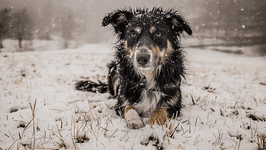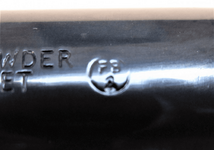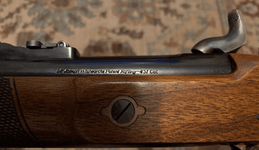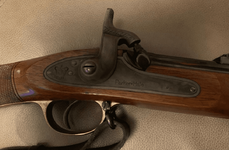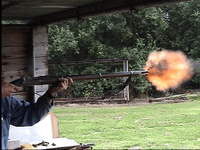- Messages
- 9,364
- Reactions
- 23,647
A pal has recently contacted me about buying a second-hand rifle in the USA which purports to be a genuine Parker-Hale rifle in all respects, having come from DGW as a used gun a number of years back.
Since there is still a lot of myth and legend (and pure hokey) surrounding these fine guns, I thought I'd put up a few pics of one of mine, the Carbine Model of 1861, often called a Musketoon, for you to use for reference. It's a very handy brush gun with a decent load, so I'm told. Here in UK it makes neither the required velocity nor the muzzle energy - so it can't possibly work, right?
Apologies for the maybe-not-so-good pics here and there, but as many of you know, taking close-ups of a round barrel can be a mite difficult.
ALL genuine BREECHED PH barrels were Birmingham proofed - no exceptions to this - it is the law here in UK since since Noah was looking at a bunch of trees and thinking what a fine boat they'd make. In the dispersion of PH's assets to Italy and the Euroarms factory, those that were simply bored through, without a breech plug, could not therefore be subject to any kind of proof back in UK, so you MAY find a PH barrel with Italian proof marks on it - it will have been fitted with a breech plug and proofed in Gardone Val Trompia, Brescia, location of Italy's national proof house.
All genuine PH-built guns stopped at around serial #9000 or so - give or take a couple of hundred. After that, the genuine PH barrels ALL ran out at around #14000. And after that, the entire gun was Italian-made.
The serial number will be stamped left on the barrel, clearly visible above the wood line. Some three-band rifle may have the letter H in front of the number - ie. H3445. This denotes Henry rifling.

Figure 1 - position and style of the serial number.
The PH cartouche will be deeply stamped on the RH bottom of the butt.

Figure 2 - brand stamp.
The barrel bands will be deep-blued to match the rest of the gun, and the furniture will ALL be brass - trigger guard and butt plate.

Figure 3 - overall view. The ramrod is the original ram rod, and remembering that this is an older production gun, a later production version MAY have a brass tip.
The nail - what you call the tang screw, will usually be colour case-hardened like the lock plate. Note than unlike the Italian versions, this is correctly done with bone fragments to give a deeply fused colour, not an overlay of bone powder 'flashed in' with a gas torch, and which readily scrapes off with a fingernail.
The proof stamps will be found at 6 o/clock on the barrel directly under the breech area - note the muzzle is pointing to the left -

Figure 4 - Left to right -
Crown over BP = Birmingham Proof.
3 1/2 DRAMS BLACK POWDER - this is the proof load - NOT the day-to-day recommended load. 1 Dram = 27.3438gr - so this is just over 95gr. Shooting THIS load with the correct bullet, a 535gr Minié, is possible, but genuinely not nice. Try it once it you care too, but by yourself, OK? The in-service British load for the Enfield rifle, two or three-band, was 2 1/2 drams - 68gr. The carbine load, where applied, was just 2 drams, about the same as the US service load for the Springfield rifled musket. All work well - you choose.
577 GRs = calibre of the arm in inches.
536 grs Bullet = weight of the appropriate Minié bullet.
Crown over crossed scepters with sundry lettering = left and right letters give the date code, and the number in the bottom centre is the ID code for the inspector - 1 = top dog, working down to 9. I've never seen anything lower than a six.
Rolled lettering on the barrel at 12 o/clock -

Figure 5 - Maker's name.
PH Lock plate -

Figure 6 - Lockplate view.
Note that some have a bolster screw. Date over Enfield, and crown over PH. Note also the fit on this fifty-year-old gun, and the quality of the colour hardening. This gun gets USED - most guest days, once a month, maybe thirty/forty shots. Another thing to note is that the barrel bands are ALL blued - not colour cased. Pedersoli and Euroarms guns are usually the latter.
And while we have made the odd mention to the PH Whitworth rifle - note the location of the title on my early PH gun -

Figure 7 - Sir Joseph Whitworths Patent Rifling - - 451 Cal.
...and the simple design of the lockplate -

Figure 8 - Whitworth rifle lockplate.

Figure 9 - Whitworth rifle - PH version.
Please feel free to correct any mistales here.
Since there is still a lot of myth and legend (and pure hokey) surrounding these fine guns, I thought I'd put up a few pics of one of mine, the Carbine Model of 1861, often called a Musketoon, for you to use for reference. It's a very handy brush gun with a decent load, so I'm told. Here in UK it makes neither the required velocity nor the muzzle energy - so it can't possibly work, right?
Apologies for the maybe-not-so-good pics here and there, but as many of you know, taking close-ups of a round barrel can be a mite difficult.
ALL genuine BREECHED PH barrels were Birmingham proofed - no exceptions to this - it is the law here in UK since since Noah was looking at a bunch of trees and thinking what a fine boat they'd make. In the dispersion of PH's assets to Italy and the Euroarms factory, those that were simply bored through, without a breech plug, could not therefore be subject to any kind of proof back in UK, so you MAY find a PH barrel with Italian proof marks on it - it will have been fitted with a breech plug and proofed in Gardone Val Trompia, Brescia, location of Italy's national proof house.
All genuine PH-built guns stopped at around serial #9000 or so - give or take a couple of hundred. After that, the genuine PH barrels ALL ran out at around #14000. And after that, the entire gun was Italian-made.
The serial number will be stamped left on the barrel, clearly visible above the wood line. Some three-band rifle may have the letter H in front of the number - ie. H3445. This denotes Henry rifling.

Figure 1 - position and style of the serial number.
The PH cartouche will be deeply stamped on the RH bottom of the butt.
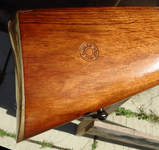
Figure 2 - brand stamp.
The barrel bands will be deep-blued to match the rest of the gun, and the furniture will ALL be brass - trigger guard and butt plate.

Figure 3 - overall view. The ramrod is the original ram rod, and remembering that this is an older production gun, a later production version MAY have a brass tip.
The nail - what you call the tang screw, will usually be colour case-hardened like the lock plate. Note than unlike the Italian versions, this is correctly done with bone fragments to give a deeply fused colour, not an overlay of bone powder 'flashed in' with a gas torch, and which readily scrapes off with a fingernail.
The proof stamps will be found at 6 o/clock on the barrel directly under the breech area - note the muzzle is pointing to the left -

Figure 4 - Left to right -
Crown over BP = Birmingham Proof.
3 1/2 DRAMS BLACK POWDER - this is the proof load - NOT the day-to-day recommended load. 1 Dram = 27.3438gr - so this is just over 95gr. Shooting THIS load with the correct bullet, a 535gr Minié, is possible, but genuinely not nice. Try it once it you care too, but by yourself, OK? The in-service British load for the Enfield rifle, two or three-band, was 2 1/2 drams - 68gr. The carbine load, where applied, was just 2 drams, about the same as the US service load for the Springfield rifled musket. All work well - you choose.
577 GRs = calibre of the arm in inches.
536 grs Bullet = weight of the appropriate Minié bullet.
Crown over crossed scepters with sundry lettering = left and right letters give the date code, and the number in the bottom centre is the ID code for the inspector - 1 = top dog, working down to 9. I've never seen anything lower than a six.
Rolled lettering on the barrel at 12 o/clock -
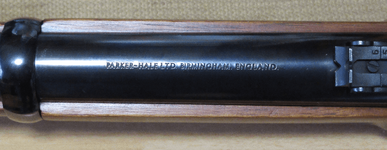
Figure 5 - Maker's name.
PH Lock plate -

Figure 6 - Lockplate view.
Note that some have a bolster screw. Date over Enfield, and crown over PH. Note also the fit on this fifty-year-old gun, and the quality of the colour hardening. This gun gets USED - most guest days, once a month, maybe thirty/forty shots. Another thing to note is that the barrel bands are ALL blued - not colour cased. Pedersoli and Euroarms guns are usually the latter.
And while we have made the odd mention to the PH Whitworth rifle - note the location of the title on my early PH gun -

Figure 7 - Sir Joseph Whitworths Patent Rifling - - 451 Cal.
...and the simple design of the lockplate -
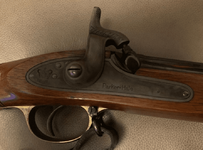
Figure 8 - Whitworth rifle lockplate.

Figure 9 - Whitworth rifle - PH version.
Please feel free to correct any mistales here.
Last Edited:






